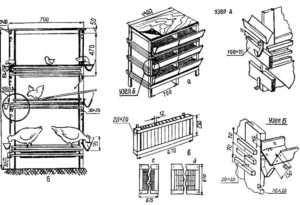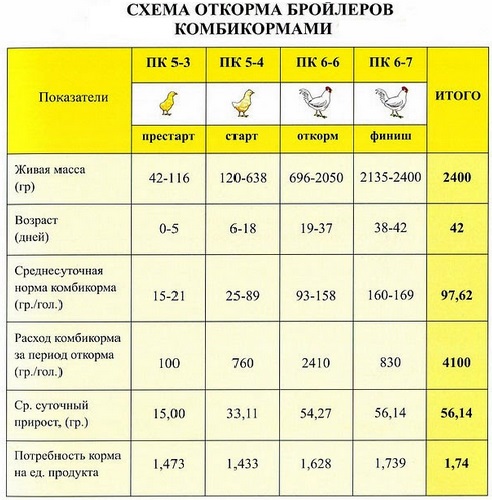Poultry meat is a popular product, so raising broilers at home for meat in a short time can become a profitable business. The keeping of meat birds differs from that of egg-laying chickens. The main difference: egg-laying birds roam a lot, while meat birds are kept in cages. Let’s delve into more details.

Initially, all chickens were raised similarly, but then breeders noticed that some chickens laid eggs better, while others gained weight quickly. This led to the division of poultry into different breeds.
However, pure broilers are now very rare on poultry farms and in home farms. Due to their breed characteristics, broilers lay eggs poorly and often do not live long enough to lay eggs. Therefore, it’s more profitable to keep hybrid chickens, known for their high productivity.
Besides poor egg-laying, broiler chickens have other characteristics: a horizontal body, short limbs, rapid weight gain, significant body mass and size (average weight is 4.5 kg for hens and 5.5 kg for roosters).
Preparation for Breeding
If you’ve decided to start breeding poultry, it’s time to acquire breeding chickens, or as experienced farmers call them – the parent flock. It’s essential to choose them carefully – the quality of the parent chickens determines the quality of all the offspring. Here are some main rules to follow when selecting quality birds.

- 1. The bird must be young and completely healthy. When purchasing, you can request veterinary documents. It’s unlikely they will be shown at the market, so it’s best to buy the parent flock from large poultry farms.
- 2. Maintain a ratio of 11 hens to 1 rooster. More roosters should not be taken, as the egg fertilization quality will be low.
- 3. Feed the breeding birds only high-quality, balanced, fresh feed.
Remember, as soon as the chickens start laying eggs, they are not yet suitable for the incubator. For breeding broilers in an incubator, the hens must be at least 8 months old.

If you plan to buy broiler chicks, it’s best to purchase 10-day-old birds. But don’t forget to ask for documents about sanitation and vaccinations.
Keeping Broilers on the Farm

As we wrote at the beginning of the article, broilers should be kept in cages. This promotes rapid weight gain, and the meat does not become tough, unlike free-range chickens.
For more details on cages, their dimensions, and structure, read our article on how to make cages for broilers with your own hands.
The litter in the cages must always be clean. It usually consists of paper, sawdust, or hay. Do not use rags or cotton for bedding – the chicken can get tangled in the fibers with its claw, cutting off blood circulation. This can lead to limb loss.
Change the water and feed in the cages; they must always be clean and fresh, otherwise, the chickens might have digestive problems.
The lighting regime should be manually regulated. Part of the cage should be shaded, and part should be lit. Chickens go to the dark part of the cages to sleep. Do not use daylight lamps for lighting cages. They flicker, which is not noticeable to the human eye, but this flickering causes stress in broilers and consequently a lack of weight gain.
The temperature regime must be observed. For chicks, it’s 30°C (86°F), for young birds – 25°C (77°F), and for adult birds, 20°C (68°F) is sufficient.
Nutrition for Broilers

As raising broilers at home for meat in a short time implies intensive feeding, many novice farmers consider this business unprofitable. They think the chicken eats more than its meat is worth. But this is not the case.
Despite the fact that the bird eats all the time except when sleeping or not wanting to, its food consumption is not that large. It’s best to feed the bird with compound feed – it’s cheaper than specialized feeds for broilers.
However, young chicks should be fed boiled eggs mashed with warm water or milk. But this is only for a short period. Around day 10, start introducing regular compound feed, soaking it in water for the first few days.

As the chicks grow, their protein intake in the diet is reduced to avoid obesity. The chicken’s diet must include grain feeds, as well as boiled and minced food waste. Some farmers advise giving the birds boiled fish minced through a meat grinder (with bones). The birds should also have drinkers; they drink water quite actively.
Check how well you are keeping the bird by feeling its crop. If it’s of normal firmness, everything is fine. If it’s very hard, there’s a lack of water, and if it’s very soft, there’s a lack of food.
Supplements for Chickens
Of course, no matter how meaty the breed is, active growth is impossible without vitamin supplements. The veterinary kit includes antibiotics against various diseases, vitamin C, and vitamins to improve digestion.

We have already discussed the peculiarities of keeping chickens at home. Now, let’s talk about how to make your own cages for broilers, including sizes and blueprints. Although cages can be bought – meeting necessary standards and dimensions – if you want to save money at the initial stage, you should do so on cages, not on chickens or feed.
Slaughter of Poultry
With proper care, broilers are ready for slaughter by 2 months. At this age, they reach their maximum weight of 4-5 kg. Note, this is the full weight of the poultry, not just the meat! Keeping them longer is pointless, as they stop growing, but still require as much feed. Very young chickens, weighing about 1.5-2 kg, are bought by restaurants preparing authentic chicken tabaka. Stores, however, prefer larger chickens, with a meat carcass weight of at least 1 kg.
To check if the bird is ready for slaughter, ruffle its feathers under the wings and on the chest. If fat lumps are visible under the skin, the chicken is ready for slaughter.
Video: Raising Broilers at Home for Meat in a Short Time
As you can see, keeping meat chickens is slightly different from keeping laying hens, but nonetheless, it is not particularly difficult. Therefore, many people raise broilers at home, as chickens can be fattened for meat in a short time, whereas they begin laying much later.






